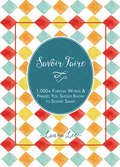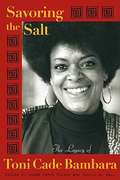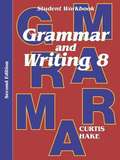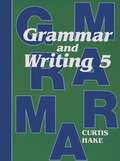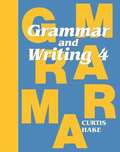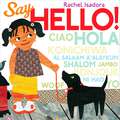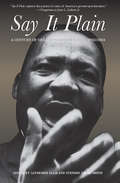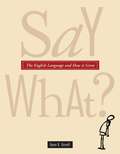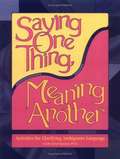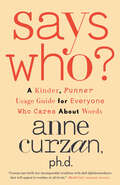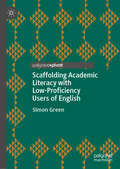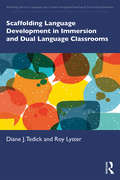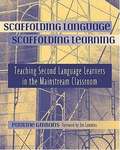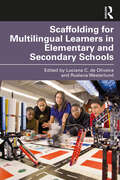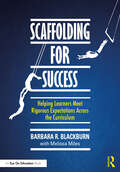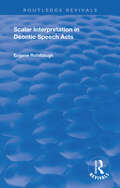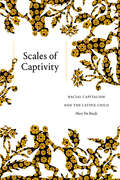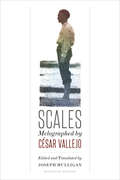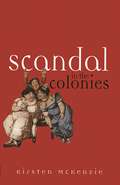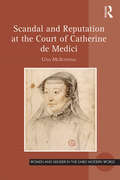- Table View
- List View
Savoir Faire Plus: Le Français à l’Université
by Géraldine EnjelvinWritten by an experienced tutor, Savoir-Faire Plus is specifically designed to meet the requirements of today’s generation of language undergraduates. Focusing on the life of an Anglophone first year undergraduate studying French in the UK and sharing a house with four francophone students, this engaging textbook provides: a clear, logical structure a blend of communicative, research-based and traditional exercises a wide range of activities covering the four key linguistic skills as well as intercultural skills authentic texts (with extracts from Le Monde, L’Express, Le Nouvel Observateur and Libération) guidance and practical tips for effective and independent learning. Each of the ten chapters consists of four topics-based sections which provide students with a wealth of diverse material allowing them to gain an in-depth knowledge of relevant topical subjects such as regional languages, sustainable development and fair trade, amongst others. Digestible grammar points are integrated throughout and a range of additional exercises are available on the Companion Website allowing students to perfect their language skills. Suitable for both self-study and class use Savoir Faire Plus is the ideal course for all advanced students of French, consolidating knowledge gained at A-Level while supporting the transition to undergraduate study. The Companion Website can be found at www.routledge.com/textbooks/9780415444750
Savoir Faire: 1,000+ Foreign Words & Phrases You Should Know to Sound Smart
by Laura LeeAn A-to-Z collection of foreign phrases to add to your lexicon—and information about the quirky, fascinating origins of the English language.Some foreign phrases are so good they become a sort of lingua franca. They capture the true zeitgeist, where the English translation is just comme ci, comme ca. If you’re a linguistics geek or language lover with a curiosity about the origins of foreign words and phrases, you need this beautifully designed reference that includes approximately 1,000 foreign phrases in languages that run the gamut from French to German to Japanese, Arabic, Sanskrit, and more. Entries offer precise translations, surprising origins, and commonly used terms you didn’t even know were foreign. (You may even find a phrase or two that you’ve been using incorrectly!) Also included are phonetic pronunciations and sidebars that explore the quirks of some favorite expressions.Don’t suffer one more trip to the museum asking yourself, “What the heck is trompe l’oeil?” Don’t put down yet another Umberto Eco novel out of sheer confusion. And avoid tumbling into the camp of declasse—instead, become one of the intelligentsia! This handy guide will make you a true cognoscente of culture.Praise for Laura Lee“Lee’s dry, humorous tone makes her a charming companion . . . She has a penchant for wordplay that is irresistible.” —San Francisco Chronicle
Savoring the Salt: The Legacy of Toni Cade Bambara
by Holmes Linda Janet Wall Cheryl A.In Savoring the Salt, a host of poets, scholars, writers, political activists and filmmakers recall Toni Cade Bambara, a woman whose voice and vision played a vital role in shaping African American culture in the last quarter of the twentieth century.
Saxon Grammar & Writing 8: Student Workbook (Second Edition) (Grammar & Writing Ser.)
by Steck-Vaughn Company WorkbookStudent Textbook: Each lesson contains instruction with examples, a set of practice questions, and a review set, which includes previous material, Weekly dictations for practice in spelling and punctuation, Suggested journal topics for student journals. Student Workbook: Writing lessons introduce students to key elements of writing, from combining sentences to constructing essays to writing short stories. Lessons include examples, practice questions, and review questions. Additional practice for grammar lessons: Fun Silly Story activities. Teacher Packet: Answers for all practice sets, review sets, and writing lessons, Schedule (144 school days), Test masters, Test answers.
Saxon Grammar and Writing Grade 5
by Steck-Vaughn Company Hake CurtisThe Student Textbook contains lessons that instruct students on eight key grammar and usage concepts: Capitalization, Punctuation, Sentence Structure, Parts of Speech, Usage, Spelling Rules, Diagramming.
Saxon Grammar and Writing: Grade 4
by Christie Curtis Mary HakeThis Grade 4 Saxon's Grammar Student Textbook contains 111 lessons and is written directly to the student. Developed to follow the classic Saxon model of incremental development and continuous review, lessons instruct students on a basic skill before moving on to examples, practice exercises, and review sets. Providing instruction on key grammar and usage concepts with bolded vocabulary and thorough examples, writing exercises are also included to help guide students through composing a complete essay. Journaling and dictation exercises help hone different writing skills. Topics covered in this Grade 4 text include types of sentences, capitalization, subject and predicate, the predicate nominative, indirect objects, phrases and clauses, proper adjectives, appositives, progressive verbs, antecedents, and more. 605 pages, indexed, softcover.
Say Chic
by Francoise Blanchard Jeremy LevenSAY CHIC...C'est magnifique! Ever wonder why some French words have become so common in English as to be clichés? Or why your witty repartee wouldn't be quite so witty without them? In Say Chic, Françoise Blanchard and Jeremy Leven collect more than seventy familiar French words and phrases that have become a permanent part of the American vocabulary. In their clever, often amusing style, the authors explain the origin of each word, its meaning, and how it came to be adopted into English. Uniting the sensibilities of an American author and a French author, these surprisingly entertaining stories combine world history, pop culture, etymology, and pithy observations about Americans and the French, with no small amount of panache. Featuring delightful illustrations, Say Chic will find its raison d'être on the bookshelf of anyone who has ever longed to be an American in Paris and hankers for a bit more of that irresistible je ne sais quoi in America.
Say Hello!
by Rachel IsadoraCarmelita loves to greet everyone in her colorful neighborhood. There are people from so many different cultures! They all like to say hello too, so now Carmelita can say hello in Spanish, English, French, Japanese, and many other languages. And her dog, Manny? Well, he seems to understand everyone, and gives a happy "Woof!" wherever he goes.Caldecott Honor winner Rachel Isadora's eyecatching collages are full of kid-friendly details like colorful storefronts, pigeons and an ice cream truck, making Carmelita's neighborhood fun to explore. Emphasizing the rich diversity of America's neighborhoods, this simple portrait of a child's day provides a great introduction to the joy of language.
Say It Plain: A Century of Great African American Speeches
by Booker T. Washington Jesse Jackson Clarence Thomas John Hope Franklin Julian Bond Martin Luther King Jr. Lani Guinier Howard Thurman Randall Robinson Stokely Carmichael Fannie Lou Hamer Joseph Lowery Dick Gregory Marcus Garvey Walter White Barbara Jordan Shirley Chisholm Thurgood Marshall Mary McLeod Bethune Charles Hamilton Houston Benjamin L. Hooks Louis Farrakhan Johnetta B. ColeA moving portrait of how black Americans have spoken out against injustice—with speeches by Thurgood Marshall, Shirley Chisholm, Jesse Jackson, and more. In &“full-throated public oratory, the kind that can stir the soul&”, this unique anthology collects the transcribed speeches of the twentieth century&’s leading African American cultural, literary, and political figures, many never before available in printed form (Minneapolis Star-Tribune). From an 1895 speech by Booker T. Washington to Julian Bond&’s sharp assessment of school segregation on the fiftieth anniversary of Brown v. Board in 2004, the collection captures a powerful tradition of oratory—by political activists, civil rights organizers, celebrities, and religious leaders—going back more than a century. Including the text of each speech with an introduction placing it in historical context, Say It Plain is a remarkable record—from the back-to-Africa movement to the civil rights era and the rise of black nationalism and beyond—conveying a struggle for freedom and a challenge to America to live up to its democratic principles. Includes speeches by: Mary McLeod BethuneJulian BondStokely CarmichaelShirley ChisholmLouis FarrakhanMarcus GarveyJesse JacksonMartin Luther King Jr.Thurgood MarshallBooker T. WashingtonWalter White
Say What I Am Called
by Dieter BitterliPerhaps the most enigmatic cultural artifacts that survive from the Anglo-Saxon period are the Old English riddle poems that were preserved in the tenth century Exeter Book manuscript. Clever, challenging, and notoriously obscure, the riddles have fascinated readers for centuries and provided crucial insight into the period. In Say What I Am Called, Dieter Bitterli takes a fresh look at the riddles by examining them in the context of earlier Anglo-Latin riddles. Bitterli argues that there is a vigorous common tradition between Anglo-Latin and Old English riddles and details how the contents of the Exeter Book emulate and reassess their Latin predecessors while also expanding their literary and formal conventions. The book also considers the ways in which convention and content relate to writing in a vernacular language. A rich and illuminating work that is as intriguing as the riddles themselves, Say What I Am Called is a rewarding study of some of the most interesting works from the Anglo-Saxon period.
Say What? The Weird and Mysterious Journey of the English Language
by Gena K. GorrellMore than a million words, weird spellings, words that are spelled the same but pronounced differently or vice versa. Where on Earth did the English language come from? The answer is that English isn't just the speech of one nation. It's the memory of thousands of years of history. It tracks the places people came from, the places they went, the adventures they had, the friends and enemies they made, the battles they won and lost. As English changed and grew, it became a jumble of sounds, words, and rules from countless languages and nations. And it's still changing and growing every day. More than seventy percent of all English words were born someplace other than England. That's why English can be so confusing and inconsistent. And that's why English is the richest, most international, and most versatile language in the world. This innovative book takes us on a journey through time to unravel and demystify the story of English. Word games, intriguing facts, and tricky quizzes add an element of fun while enriching readers' knowledge and understanding.
Saying One Thing, Meaning Another: Activities For Clarifying Ambiguous Language
by Cecile C. SpectorSaying One Thing, Meaning Another provides background information and materials necessary for educators to help individuals ages 10 through adult improve their understanding and use of ambiguous language. The activities use a cognitive approach to address deficits in the comprehension of multiple meaning words, idioms, irony, indirect and direct polite requests, and polite evasions. Use this book with individuals of normal development, those with language learning disorders, the hearing impaired, those with brain injury, as well as ESL students.
Says Who?: A Kinder, Funner Usage Guide for Everyone Who Cares About Words
by Anne CurzanA kinder, funner usage guide to the ever-changing English language and a useful tool for both the grammar stickler and the more colloquial user of English, from linguist and veteran professor Anne Curzan &“I was bowled over, page after page, by the author&’s fine ear for our language and her openhearted erudition. I learned a lot, and I couldn&’t have enjoyed myself more.&”—Benjamin Dreyer, New York Times bestselling author of Dreyer&’s EnglishOur use of language naturally evolves and is a living, breathing thing that reflects who we are. Says Who? offers clear, nuanced guidance that goes beyond &“right&” and &“wrong&” to empower us to make informed language choices. Never snooty or scoldy (yes, that&’s a &“real&” word!), this book explains where the grammar rules we learned in school actually come from and reveals the forces that drive dictionary editors to label certain words as slang or unacceptable.Linguist and veteran English professor Anne Curzan equips readers with the tools they need to adeptly manage (a split infinitive?! You betcha!) formal and informal writing and speaking. After all, we don&’t want to be caught wearing our linguistic pajamas to a job interview any more than we want to show up for a backyard barbecue in a verbal tux, asking, &“To whom shall I pass the ketchup?&” Curzan helps us use our new knowledge about the developing nature of language and grammar rules to become caretakers of language rather than gatekeepers of it. Applying entertaining examples from literature, newspapers, television, and more, Curzan welcomes usage novices and encourages the language police to lower their pens, showing us how we can care about language precision, clarity, and inclusion all at the same time.With lively humor and humanity, Says Who? is a pragmatic and accessible key that reveals how our choices about language usage can be a powerful force for equity and personal expression. For proud grammar sticklers and self-conscious writers alike, Curzan makes nerding out about language fun.
Sbisà on Speech as Action (Philosophers in Depth)
by Laura Caponetto Paolo LabinazThe volume provides a thorough look into Marina Sbisà’s distinctive, Austinian-inspired approach to speech acts. By gathering original essays from a world-class lineup of philosophers of language, linguists, social epistemologists, action theorists, and communication scholars, the collection provides the first comprehensive critical treatment of Sbisa’s outstanding contribution to speech act theory.
Scaffolding Academic Literacy with Low-Proficiency Users of English
by Simon GreenThis book analyses the development of academic literacy in low-proficiency users of English in the Middle East. It highlights the challenges faced by students entering undergraduate education in the region, and the strategies used by teachers to overcome them. The author focuses on a large-scale undergraduate teacher programme run in Oman by the University of Leeds, providing clear pointers both for future research and effective practice. He also explores the implications of his findings for countries beyond the Gulf Cooperation Council, demonstrating how international participation in UK HE could be much wider. This book will appeal to students and scholars with an interest in academic literacies and English for Academic Purposes.
Scaffolding Language
by Pauline GibbonsThe bestselling Scaffolding Language, Scaffolding Learning helped tens of thousands of mainstream elementary teachers ensure that their English language learners became full members of the school community with the language and content skills they needed for success. In the highly anticipated Second Edition, Pauline Gibbons updates her classic text with a multitude of practical ideas for the classroom, supported by the latest research in the field of ELL/ESL. With clear directions and classroom tested strategies for supporting students' academic progress, Gibbons shows how the teaching of language can be integrated seamlessly with the teaching of content, and how academic achievement can be boosted without sacrificing our own vision of education to the dictates of knee-jerk accountability. Rich examples of classroom discourse illustrate exactly how the scaffolding process works, while activities to facilitate conversation and higher-level thinking put the latest research on second language learning into action.
Scaffolding Language Development in Immersion and Dual Language Classrooms (Routledge Series in Language and Content Integrated Teaching & Plurilingual Education)
by Roy Lyster Diane J. TedickThis book introduces research-based pedagogical practices for supporting and enhancing language development and use in school-based immersion and dual language programs in which a second, foreign, heritage, or indigenous language is used as the medium of subject-matter instruction. Using counterbalanced instruction as the volume’s pedagogical framework, the authors map out the specific pedagogical skill set and knowledge base that teachers in immersion and dual language classrooms need so their students can engage with content taught through an additional language while continuing to improve their proficiency in that language. To illustrate key concepts and effective practices, the authors draw on classroom-based research and include teacher-created examples of classroom application. The following topics are covered in detail: defining characteristics of immersion and dual language programs and features of well-implemented programs strategies to promote language and content integration in curricular planning as well as classroom instruction and performance assessment an instructional model to counterbalance form-focused and content-based instruction scaffolding strategies that support students’ comprehension and production while ensuring continued language development an approach to creating cross-linguistic connections through biliteracy instruction a self-assessment tool for teachers to reflect on their pedagogical growth Also applicable to content and language integrated learning and other forms of content-based language teaching, this comprehensive volume includes graphics to facilitate navigation and provides Resources for Readers and Application Activities at the end of each chapter. The book will be a key resource for preservice and in-service teachers, administrators, and teacher educators.
Scaffolding Language, Scaffolding Learning: Teaching Second Language Learners in the Mainstream Classroom
by Jim Cummins Pauline GibbonsHow does a mainstream elementary classroom teacher with little or no specialized ESL training meet the challenge of teaching linguistically diverse students? Pauline Gibbons suggests how: integrate the teaching of English with the content areas of the regular curriculum. What's more, she shows how in this practical resource book. Gibbons begins with a strong theoretical underpinning for her practice, drawing on a functional model of language, sociocultural theories of learning, and current research on second-language development. After supporting her view that the regular curriculum offers the best language-learning environment for young ESL students, Gibbons demonstrates the ways in which content areas provide a context for the teaching of English, from speaking and listening to reading and writing. These in turn are treated not as discrete skills, but as ones that can also be integrated in the learning of diverse subjects. Gibbons illustrates this with a wide range of teaching and learning activities across the curriculum, supplemented with programming and assessment formats and checklists. Language learning is not a simple linear process, but involves the ongoing development of skills for a range of purposes. Gibbons sees this development as largely the result of the social contexts and interactions in which learning occurs. By focusing on the ways in which teachers can "scaffold" language and learning in the content areas, she takes a holistic approach-one that appreciates the struggle of students learning a new language, while simultaneously developing subject knowledge in it, and the challenge for teachers to address these needs. Given today's culturally and linguistically diverse classrooms, ESL students can no longer be thought of as a group apart from the mainstream-they are. the mainstream. This book describes the ways to ensure that ESL learners become full members of the school community with the language and content skills they need for success.
Scaffolding for Multilingual Learners in Elementary and Secondary Schools
by Luciana C. de Oliveira Ruslana WesterlundThis insightful and timely volume addresses how scaffolding can be used to support multilingual learners to amplify their opportunities for learning. As a dynamic educational process, scaffolding facilitates responsive and adaptive teaching and learning; addresses students’ needs; increases student autonomy; and promotes adaptive, high-level learning without simplifying instruction. Section I covers the theoretical grounding and reconceptualizations of scaffolding. Section II offers concrete examples and case studies from varied classroom contexts. Section III provides a window into professional development to discuss the work of pre-service and in-service teachers, and how they develop their understandings and practices of teaching multilingual learners. Contributors address diverse topics, including translanguaging in the classroom, scaffolding as a tool for equitable teaching, virtual learning, as well learning in dual language and content area classrooms. Featuring examples from teacher education programs as well as principles for design of educative curriculum materials, this book is ideal for pre-service teachers and students in TESOL, applied linguistics, and language education.
Scaffolding for Success: Helping Learners Meet Rigorous Expectations Across the Curriculum
by Barbara R. BlackburnSupport and scaffolding are critical for moving students to higher levels of learning. But how do we ensure we’re giving the “right” work and not just extra work? Barbara R. Blackburn has the answers in this important new book. She provides a plethora of strategies for helping students create meaning and become more independent so they can truly learn at rigorous levels.First, she examines the basics of rigor and scaffolding and uncovers the role of planning in scaffolding, including the difference between acceleration and remediation and examples of differentiating instruction with scaffolding. Then she demonstrates a variety of ways to add scaffolding into classroom discourse, vocabulary, comprehension, and writing across the curriculum. Ideas and strategies are provided for different subject areas and levels, so you can easily apply them to your own setting. And finally, she shows the roles of formative assessment and social emotional learning in scaffolding.With this practical book, you’ll have a toolkit of great ideas at your disposal as you foster a learning environment of high expectations and success.
Scalar Interpretation in Deontic Speech Acts
by Eugene RohrbaughFirst Published in 1997. As the title suggests, this book is about the interpretation of scalar terms in commands and permission sentences. Why limit our study of the semantics of this class of lexical items to commands and permissions? In short, because there is more than enough to say about this mere subset of environments. Add to that the fact that reams have been written about scalar implicature in assertions, whereas relatively little has been said about the use of scalar terms in other types of illocutionary acts.
Scales of Captivity: Racial Capitalism and the Latinx Child
by Mary Pat BradyIn Scales of Captivity, Mary Pat Brady traces the figure of the captive or cast-off child in Latinx and Chicanx literature and art between chattel slavery’s final years and the mass deportations of the twenty-first century. She shows how Latinx expressive practices expose how every rescaling of economic and military power requires new modalities of capture, new ways to bracket and hedge life. Through readings of novels by Helena María Viramontes, Oscar Casares, Lorraine López, Maceo Montoya, Reyna Grande, Daniel Peña, and others, Brady illustrates how submerged captivities reveal the way mechanisms of constraint such as deportability ground institutional forms of carceral modernity and how such practices scale relations by naturalizing the logic of scalar hierarchies underpinning racial capitalism. By showing how representations of the captive child critique the entrenched logic undergirding colonial power, Brady challenges racialized modes of citizenship while offering visions for living beyond borders.
Scales: Melographed by César Vallejo
by César Vallejo Joseph MulliganFirst published in 1923, just before César Vallejo left Peru for France, Scales combines prose poems with short stories in a collection that exhibits all the exuberance of the author’s early experimentalism. A follow-up to Vallejo’s better-known work, Trilce, this radical collection shattered many aesthetic notions prevailing in Latin America and Europe. Intermingling romantic, symbolist, and avant-garde traditions, Scales is a poetic upending of prose narrative that blends Vallejo’s intercontinental literary awareness with his commitment to political transformation. Written in part from Trujillo Central Jail, where Vallejo would endure some of the most terrifying moments of his life, Scales is also a testament of anguish and desperation, a series of meditations on justice and freedom, an exploration of the fantastic, and a confrontation with the threat of madness. Edited and translated from the Castilian by the scholar Joseph Mulligan, this first complete English translation, published here in bilingual format and accompanied by extensive archival documentation related to Vallejo’s incarceration, this volume gives unprecedented access to one of the most inventive practitioners of Latin American literature in the twentieth century.
Scandal In The Colonies
by McKenzie, KirstenIn 1830s Sydney, a visiting aristocrat, Viscount Lascelles, is exposed as a former convict. In Cape Town, during the same decade, veiled accusations of incest and murmurs about a concealed pregnancy surround the family of the Chief Justice, Sir John Wylde. In these British colonies, the divide between the respectable and the disreputable is not as vast as might first appear. Rumour and hearsay muddy the lines between public and private worlds, and ensure that secret transgressions do not remain secret for very long. Scandal in the Colonies explores how colonial societies offered European settlers the opportunity to invent new identities, an opportunity exploited with a vengeance. But as people, goods and correspondence crossed the imperial realm, scandal was never far behind. In this lively and richly researched book Kirsten McKenzie uncovers the hidden stories of two port towns that were rife with gossip and dubious reputations. She argues that scandal influenced imperial policy and became a key element in the emergence of societies divided by class and race. Touching on themes such as masculinity and commercial culture, female sexuality in civil litigation and gossip in political culture, McKenzie offers a fresh and engaging approach to colonial history.
Scandal and Reputation at the Court of Catherine de Medici (Women and Gender in the Early Modern World)
by Una McIlvennaScandal and Reputation at the Court of Catherine de Medici explores Catherine de Medici's 'flying squadron', the legendary ladies-in-waiting of the sixteenth-century French queen mother who were alleged to have been ordered to seduce politically influential men for their mistress's own Machiavellian purposes. Branded a 'cabal of cuckoldry' by a contemporary critic, these women were involved in scandals that have encouraged a perception, which continues in much academic literature, of the late Valois court as debauched and corrupt. Rather than trying to establish the guilt or innocence of the accused, Una McIlvenna here focuses on representations of the scandals in popular culture and print, and on the collective portrayal of the women in the libelous and often pornographic literature that circulated information about the court. She traces the origins of this material to the all-male intellectual elite of the parlementaires: lawyers and magistrates who expressed their disapproval of Catherine's political and religious decisions through misogynist pamphlets and verse that targeted the women of her entourage. Scandal and Reputation at the Court of Catherine de Medici reveals accusations of poisoning and incest to be literary tropes within a tradition of female defamation dating to classical times that encouraged a collective and universalizing notion of women as sexually voracious, duplicitous and, ultimately, dangerous. In its focus on manuscript and early print culture, and on the transition from a world of orality to one dominated by literacy and textuality, this study has relevance for scholars of literary history, particularly those interested in pamphlet and libel culture.

